Seeds of Campaign Finance Commission Debacle Planted in Broken State Budget Process

Heastie & Cuomo (photo: governor's office)
This week, the state campaign finance commission, created out of the backroom dealings of the 2019 budget process, released a set of flawed recommendations for a small-donor public matching campaign finance system despite workable alternative recommendations provided by experts and activists alike. In addition, by deviating from its primary mission by focusing on a petty attempt by Governor Andrew Cuomo and his allies to eliminate third parties like the Working Families Party, the commission made a mockery of the countless hours spent by New Yorkers who showed up at hearings across the state.
It should never have gotten to this point. For years, a majority of members in the Assembly said they supported public financing. The newly elected Senate Democratic majority campaigned on plans to uplift the voices of everyday New Yorkers. The governor has claimed support for public financing for years. And make no mistake, the pillars of a strong public financing bill exist.
The Legislature squandered the chance during the legislative session to introduce and pass a gold standard bill drafted by the Brennan Center, which unlike the commission’s recommendations, would have more thoroughly reduced the influence of big money donations in our politics and more effectively enabled new voices to run for office.
So how is it possible that the details of a widely supported democracy reform policy could be left in the hands of an unelected, undemocratic commission in the first place? I’d argue it was 15 years in the making.
The state budget is built on the power of appropriations, allocating specific funds to specific purposes. You might think that in a functional democracy, the elected officials that New Yorkers vote for and send to Albany would have a shared responsibility in that process. It seems only logical that the Legislature and the Governor would negotiate a budget that’s consistent with their constituencies’ desires. But in New York, this is simply not the case.
In 2004, the Court of Appeals issued a decision in Silver v Pataki that laid out a division of power between the executive and legislative branches that has enabled the Governor to wield tremendous control over the New York State budget and appropriations. The court’s interpretation of the separation of powers in the state constitution means that when it comes to appropriations bills, the Senate and Assembly can only reduce or fully eliminate the Governor’s proposed spending. And while the Legislature can add proposed spending, the Governor has the power to veto those additions.
Throughout his time in office, Governor Cuomo has tested the limits of this interpretation, introducing more and more policy and reform into appropriations bills, insisting on “on-time” budgets, playing legislators off each other, and creating an untenable position for legislators fighting for a more progressive budget. With very little leverage to negotiate modifications, legislators must choose between accepting the governor’s austerity driven budget packed with oft-watered-down policy, or shut down the government.
However, the Legislature, including the latest Democratic majorities, has also been complicit in the creation of our broken budget process. Complex policy decisions are jammed into the budget, even outside of appropriations bills, which enable legislators to avoid public scrutiny on the final make-up of the legislation being passed and to provide cover for controversial votes.
The Governor and Legislature are collectively responsible for punting campaign finance reform to this unelected commission. And it was amid the backroom compromise, enabled by Assembly Speaker Carl Heastie and Senate Majority Leader Andrea Stewart-Cousins, where the governor incorporated language that opened up the potential for the commission to weigh in on political party qualifications. The final recommendations from the campaign finance commision have now validated the fears of those who rightly saw the commission as a mistake and the party-related language as an unnecessary, dangerous sideshow.
So where do we go from here?
First, there are two paths forward in overcoming the Court of Appeals decision issues on Silver v Pataki. One path is a re-litigation strategy aimed at overturning the previous ruling. But the surest way to tackle this challenge is through a constitutional amendment, introduced and passed in two subsequent legislative sessions.
Some will tell you that challenging the Silver v Pataki decision is an uphill battle; that the likelihood of a constitutional amendment passing a Legislature fearful of the Governor’s blowback is low. But it wasn’t that long ago that another power dynamic, widely considered unbeatable, held our state back from delivering on a vision of a fairer, cleaner, and more equitable New York. Yet in 2018, New Yorkers worked together to shine a light on the Independent Democratic Conference (IDC) and organized to eliminate its stranglehold on the State Senate.
Second, it’s time for New Yorkers to turn their attention to the state’s budget process and demand a true commitment to transparency. Public policy should not be negotiated behind closed doors. The historical “three men in a room” budget negotiation was meant to be upended with the election of our first woman leader of the State Senate, but sadly much of the negotiations of this past year’s budget remained as opaque as recent years.
In 2020, legislators and insurgent candidates will have another chance to share their visions for our state. If they don’t acknowledge and rally against the Governor’s overreach in budgetary powers enabled by the Silver v Pataki decision and commit to removing policy negotiations from the budget, their broader campaign promises should be taken with a hefty dose of skepticism.
Years from now, I hope we will look at the failures of the 2019 state campaign finance commission as the breaking point that led to a re-alignment of power in Albany; the moment when New York’s undemocratic budget process hamstrung the state’s ability to lead the nation in expanding and strengthening our democracy.
***
Ricky Silver is the co-lead organizer of Empire State Indivisible. On Twitter @es_indivisible.
***
Have an op-ed idea or submission for Gotham Gazette? Email This email address is being protected from spambots. You need JavaScript enabled to view it.
National Grid Deal Shows Best and Worst of Cuomo
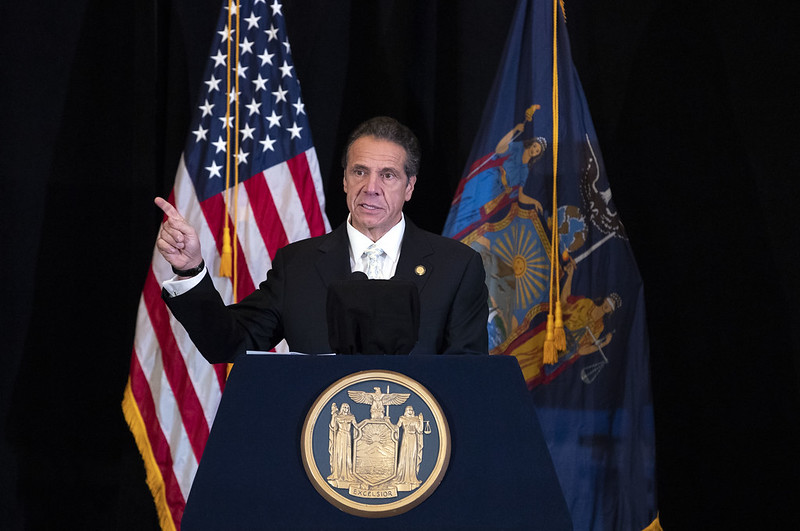
Gov. Cuomo (photo: Mike Groll/Governor's Office)
The saga over the National Grid moratorium on gas hookups illustrates both the best and worst of Governor Andrew Coumo.
The fact that Cuomo was able to get the utility to back down from its moratorium, despite the long-term facts being on its side, is exhibit A that Cuomo is a master politician. He knows how to play the game and to control the spin. On the other hand, it once again reminds us of the governor’s penchant for egregious pandering to special interest groups he is courting and the eventual harm that it will cause to the welfare of the state.
Early in his first term, Cuomo followed through with his promise to be a strong fiscal manager. He clamped down on extravagant healthcare increases and earnestly sought to keep state spending within a self-imposed limit of 2% annual growth. He shepherded through a very much needed property tax cap, even though he exempted New York City from the constraints.
But, as time went on, he saw that it was the radical left that was gaining momentum in the state, and fearing a primary defeat at the polls, he switched gears. His early devotion to spending limits morphed into a bunch of budgetary gimmicks whereby he claimed he was staying within his 2% threshold, but was actually spending at twice that pace. A glaring recent example is the disingenuous machinations he’s employing with Medicaid by shifting present costs into future years and a ballooning deficit.
Then there was his earlier pandering to environmental extremists, starting with his putting the Kibosh on fracking in New York. This was devastating to the upstate economy. While Pennsylvania and Ohio communities flourish thanks to fracking, New York upstate communities continue to languish in a forgotten Rust Belt status. And it was all to boost his bona fides with the radical greens, whom he did not want dogging him during his reelection bid and he perhaps hoped would support him in a potential run for the presidency.
While he’s not running this year, those ambitions likely weigh heavily on his mind, as he recently declared war on not only National Grid but also Con Edison in their efforts to get needed pipelines laid to bring residents and businesses natural gas to heat their homes and stores.
The governor’s reasoning is purely political and downright dangerous. National Grid is not making up the fact that more capacity is needed to fuel our growing energy needs. A pipeline is the safest and most affordable method of transporting gas. Yet, Cuomo had his agency block the laying of the pipe on the most specious environmental arguments that it will somehow pollute our waterways.
Ironically, the deal that he has struck with National Grid to end its moratorium calls for the needed supply of gas to be brought into our area via tractor-trailer trucks.
Is this a joke? Has anyone calculated the carbon footprint of adding all of these tractor-trailers onto our already congested roadways?
Cuomo has his checklist: there’s something for every interest group, with the environmentalists getting a pie in the sky effort to eliminate natural gas and other fossil fuels over the next few years.
The irony is that it is natural gas that is responsible for the United States being one of the only industrialized nations to have actually reduced its carbon footprint over the last 15 years. It simultaneously made us energy independent from Middle East tyrants, while boosting our economy and making us the number one producer of energy worldwide.
Solar, wind, and other alternative sources certainly must be in our energy portfolio, but it is pure folly to believe that we are prepared at this point to shut the spigot off the natural gas pipelines.
Just because National Grid can continue to supply new hook-ups with needed gas does not mean that we aren’t heading toward a crisis without necessary pipelines. Many will look at this deal crafted between Cuomo and the utility as putting the controversy to rest. To the contrary, the headaches have just begun.
The New York Post reported just last month that Public Service Commissioner John Howard conceded: “This short-term reaction was, `We need more gas.’ That’s an undeniable fact.” Another Commissioner, Tracy Edwards, admitted: “We have capacity issues.” And a third, Diane Burman, said: “Those who say ‘No new pipelines’ should look at what the ramifications are.”
Cuomo comes out the victor in the short-term by making National Grid bow to his aggressive ways, including the threat of imposing even heavier fines and revoking their license to operate in New York. (Though I wonder if his strong-arm tactics would have held up in court, had National Grid maintained the resolve to take it to the next step.)
Nevertheless, with the assistance of a politically-aligned liberal Attorney General's office, the governor adroitly put the utility in a corner. The utility lost this round and Cuomo put another notch in his belt, but in a few years when our utility rates go through the roof and supplies are once again threatened, it will be the residents and businesses of New York who will be the real losers.
***
Steve Levy is President of Common Sense Strategies, a political consulting firm. He served as Suffolk County Executive, as a New York Assembly member, and host of "The Steve Levy Radio Show." He is the author of “Bias in the Media” and is on Twitter @SteveLevyNY.
***
Have an op-ed idea or submission for Gotham Gazette? Email This email address is being protected from spambots. You need JavaScript enabled to view it.
New York City Needs a Development Reset – Starting with Public Land
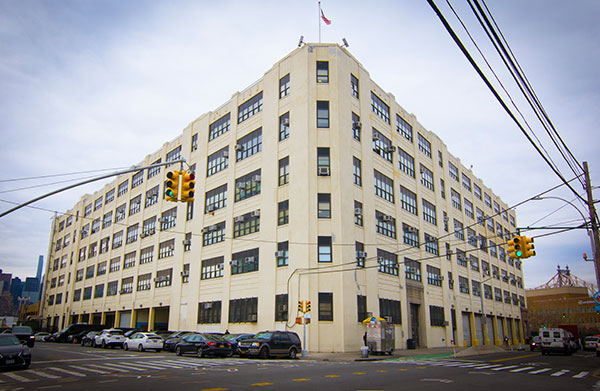
City-owned building at Vernon Blvd & 44th Dr (photo: Memo Salazar)
2019 may go down in history as the year public disenchantment with New York City’s land use policies reached a boiling point.
In June, protestors disrupted a meeting about a neighborhood study for a potential rezoning on Southern Boulevard in the Bronx, claiming that city agencies did not really want their opinions. In August, a judge heard arguments in a lawsuit challenging the 2018 Inwood rezoning, with groups in that Upper Manhattan neighborhood charging that the environmental impact study undertaken there was illegitimate. In September, resident groups publicly assailed City Council Member Carlos Menchaca when he proposed to enter into community benefits negotiations with Industry City Associates, which had applied for a private zoning change in Brooklyn’s Sunset Park. That same night, Queens activists turned an Economic Development Corporation-sponsored meeting about the Sunnyside Yard master plan into a raucous “teach-in,” loudly expressing their conviction that the city was failing to elevate the public interest over the aims of real estate developers.
What explains this increasing lack of faith in government’s good intentions?
Part of the problem, as others have pointed out, is that the city has no framework with which to strategically coordinate land use changes and infrastructure investments. Without a comprehensive planning process to guide investment decisions and resolve equity tradeoffs, the city’s moves to densify and develop in particular neighborhoods are met with fear and protest.
But also part of the problem is the de Blasio administration’s outdated mindset with respect to development more generally -- particularly development on land owned by the city. The practice of selling publicly-owned sites to developers to raise revenue, and to promote the creation of new, mostly market-rate housing and office inventory, became commonplace under Mayor Michael Bloomberg. The de Blasio administration has continued the practice, frustrating those of us who believe there are better uses for public land.
To take one example: in Long Island City, Queens, a battle is brewing about the fate of two sites in Anable Basin. Located on 44th Drive close to the waterfront, they are currently owned by the public. But they have a history: in 2018, the city’s Economic Development Corporation had issued requests for proposals or requests for expressions of interest for them, and come to a preliminary agreement with the development firm TF Cornerstone to build and operate a mixed-use development (with residential, commercial, and some industrial uses) on one of them. Then came Amazon. Last November, the sites appeared on the map of the planned HQ2 campus.
When the Amazon deal fell through in February of this year, the city went silent, and local activists (many of whom had fought HQ2) started thinking not just about what they didn’t want in their neighborhood but about equity-positive alternatives.
Last summer, a coalition formed around the aim of creating a Community Land Trust (CLT), which provides a vehicle for permanently affordable development managed by mission-driven organizations. The land trust activists developed a plan to renovate one of the city-owned sites – a 638,000 square foot industrial building at 44th Drive and Vernon Boulevard – as a multi-tenant space for small manufacturers, working artists, a commercial kitchen, and a school. A non-profit partner selected to operate the space would be subject to a special deed, drawn up by the land trust, that compels them to charge below-market rent in perpetuity to the kinds of tenants who are currently being displaced from Long Island City in droves by luxury development.
Judging by the YourLIC planning exercise announced last month, the city appears to have other plans for the sites the public owns in Anable Basin. But before things go any further, the de Blasio administration should consider conveying the site at 44th Drive and Vernon Boulevard to the Western Queens Land Trust.
On land it owns, the city should be leading by example, fostering development that creates family-supporting jobs and offers open space and public facilities (like schools) without contributing to gentrification and displacement. An indication of what is possible in Long Island City can be seen on the activists’ website, OURlic.nyc.
We have set the bar too low for too long. Using public land, the city can subsidize development that improves communities without making them unaffordable to the people who currently live there. This path is not the most lucrative option in financial terms. But the highest and best use of land need not always be the use that commands the highest investor return. In Long Island City and elsewhere, conveying city-owned property to land trusts and other mission-driven organizations is an investment in neighborhood value that could help earn back the trust of the currently disenchanted.
***
Laura Wolf-Powers is an associate professor in the Department of Urban Policy and Planning at Hunter College. On Twitter @wolf_powers.
***
Have an op-ed idea or submission for Gotham Gazette? Email This email address is being protected from spambots. You need JavaScript enabled to view it.
Hidden in Plain Sight: Billions in Potential Revenue for NYCHA

(East Harlem NYCHA superblocks possess massive amounts of unbuilt air and ground space, as illustrated in the HOUSING DENSITY show currently on view at the Skyscraper Museum.)
NYCHA developments full of high-rises seem massive from a distance, but on closer examination their visual bulk disguises a deeper truth: they are dominated by open space. What to do with all this unbuilt space has inspired competing and controversial plans for infill and redevelopment. A growing number of policy experts believe that the New York City public housing authority would benefit just as much from a more aggressive program to transfer development rights for cash. They are right.
That NYCHA is “underbuilt” has been known for decades, but the general consensus has been that the rules governing Transferable Development Rights made it impossible for the housing authority to monetize the unbuilt square footage. Large NYCHA superblocks frequently lack adjoining parcels to which these rights could be transferred under current rules. NYCHA, to most eyes, appeared to be landlocked.
Intrepid staff at the Regional Plan Association have now calculated that a straightforward rule change (a city Zoning Text Amendment) could put into play an astounding 78 million square feet of NYCHA’s transferable rights. Selling these rights, they estimate, could yield $4.2 to $8 billion for NYCHA repairs.
The key to unlocking these revenues is to allow the authority more flexibility than typical property owners in moving its Transferable Development Rights around the city. By moving NYCHA air rights across the street, up to a half mile away, or within a Community District, the opportunities for revenue generation increase exponentially.
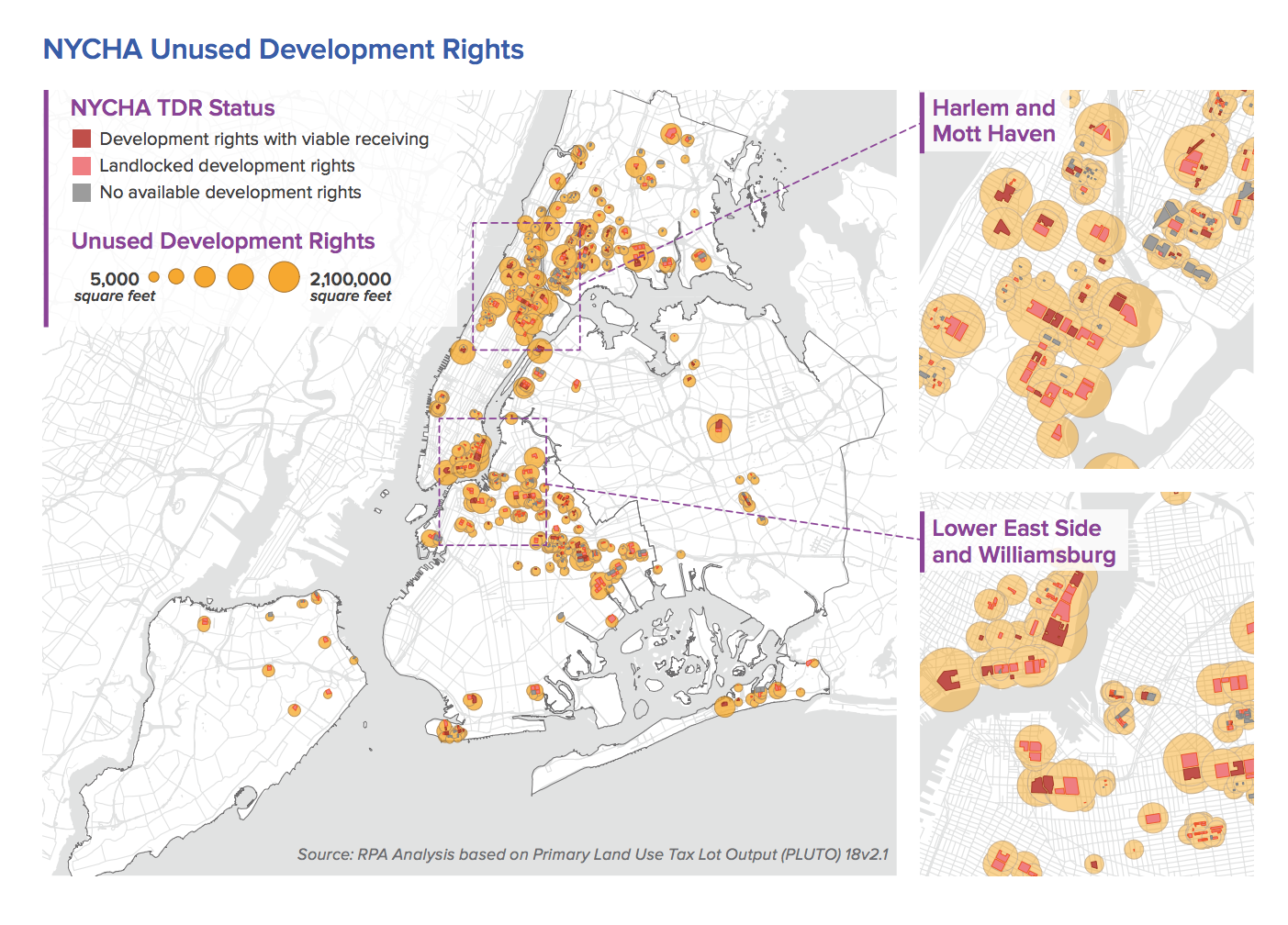 (Image Courtesy Regional Plan Association, Time to Act)
(Image Courtesy Regional Plan Association, Time to Act)
These eye-popping revenue projections could be game-changing when it comes to paying for much-needed repairs of boilers, apartments, and more.
Relying more on development transfers would also defer a growing number of pitched battles over infill and redevelopment. As illustrated in the HOUSING DENSITY exhibit at the Skyscraper Museum, low-density NYCHA superblocks (even in their rundown state) offer current residents a style of living that is difficult to replicate anywhere else in New York. Where else in the city can you find relatively large apartments (avg. rent $533 per month per apartment) with windows in every room looking out on open space, trees, and the city?
Infilling NYCHA with new structures will not only take away some of the city’s last open spaces, and tree canopy, but will further undermine the remaining quality of life for current NYCHA residents. Less air flow, fewer trees, and reduction in permeable surfaces seems like a bad idea for a warming city. Infill projects are, therefore, stalling out for a good reason. Redevelopment projects of buildings and grounds offer a brighter hope for completely rethinking NYCHA’s midcentury tower-in-the-park formula, but so far the politics of redevelopment are even more fraught than infill.
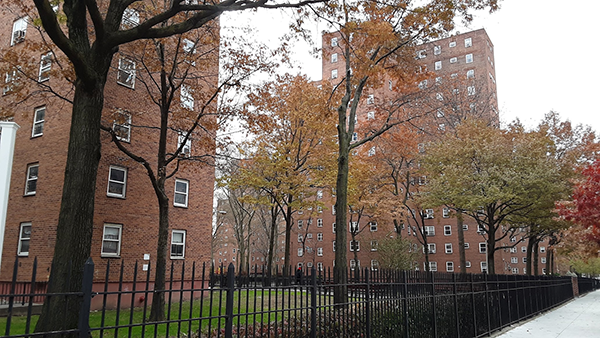
(Johnson Houses in East Harlem: Just one of many NYCHA developments with extensive tree cover and lawns.)
As with all things NYCHA, a major policy shift on Transferable Development Rights will generate enormous resistance -- but probably not from NYCHA residents. Instead, it will be NYCHA neighbors, some of them blocks away from current projects, who will feel the impact. If this proposal moves forward they will find that many builders can upsize their plans for development. Expect a backlash from non-NYCHA neighborhood activists and those that represent them including city, state, and federal elected officials.
Some say the politics would be too difficult and few city leaders have embraced this brave plan as of yet. There is, however, a double standard here that should be addressed. Politicians found a way, for instance, to make similar changes in East Midtown in the name of commercial modernization. Zoning text changes there enriched a few billionaire property owners, and were achieved over some vocal community objections, so why not make similar changes for the benefit of NYCHA’s 400,000 residents?
It is hard, moreover, to have much empathy for city residents and their elected officials resistant to finding alternative funding sources for NYCHA. It is true that Mayor de Blasio has committed unprecedented local funds to NYCHA, but the City of New York has found much more additional money for generous labor contracts, ferries, new jails, and bike paths, while allowing NYCHA residents to face another winter with very old boilers. If politicians and non-NYCHA residents are unalterably opposed to Regional Plan Association’s proposals, they should at least propose an alternative means of financing the $30+ billion renovations NYCHA needs.
In the meantime, the treasure hidden away in underbuilt NYCHA superblocks should be used as a major downpayment for immediately upgrading resident life.
***
Nicholas Dagen Bloom, Professor of Urban Policy and Planning, Hunter College is author of Public Housing That Worked, How States Shaped Postwar America: State Government and Urban Policy, and a co-curator of the HOUSING DENSITY show.
***
Have an op-ed idea or submission for Gotham Gazette? Email This email address is being protected from spambots. You need JavaScript enabled to view it.
Commission Failure Shows Need for One True Fix for New York Elections
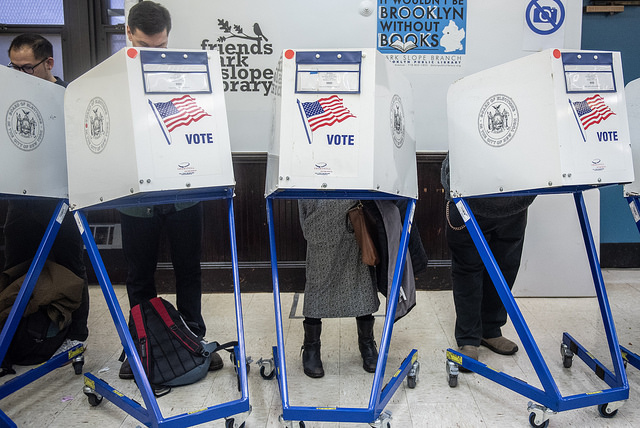
(photo: Michael Appleton/Mayor's Office)
Looking at the plan from the state campaign finance commission, anyone who’s had even a passing interest in New York politics is left either scratching their head or gritting their teeth (maybe both). It’s no surprise that the aspects of the commission’s just-completed work that have provoked the most vociferous opposition and passionate debate have nothing whatsoever to do with public campaign financing. On the left and on the right, activists, lawmakers, and good government groups are decrying the elements of the plan that would eventually kill off every minor party in the state and keep other potential new ones from sprouting up.
These recommendations include raising the number of votes necessary to retain ballot access, going from 50,000 to a minimum of 130,000 and making it a biennial rather than quadrennial test. Given recent voting trends, the move would kill off every minor party in the state except one - the Conservative Party. Trust me, as a leader in a political party (the Reform Party) that just lost ballot access under the existing thresholds, I can tell you that getting 50,000 votes is no walk in the park.
Potentially even more alarming, though, is the dramatic increase in the number of signatures necessary to qualify for the ballot statewide, going from 15,000 to 45,000. This increase would reserve ballot access for only the super wealthy or the hand-picked candidates of the political establishment or certain deep-pocketed special interests, very likely keeping new parties from sprouting up (as two did last year to make the ballot: SAM and Libertarian).
If the Legislature allows these new rules to be implemented, it would likely bring an end to New York’s longtime history of having robust and influential minor parties. It’s a tradition that goes back well over a century in our state. So, why do this? Is the public really clamoring for a less crowded ballot with fewer choices? Of course not!
Aside from a scorned governor seeking vengeance on a political rival (Andrew Cuomo and The Working Families Party), there is actually ample reason to think that our current system, where minor party bosses are treated like major power-brokers, doesn’t work well.
We’ve seen time and again over the last half-century example after example of parties with paltry memberships and even smaller vote totals be showered in patronage jobs, direct donations, policy-making roles, and more in exchange for their ballot lines. In some cases fusion voting in this state has produced minor party leaders (baby bosses) who seem like their sole reason for maintaining a party is acquiring of money and patronage, with little regard for anything resembling a coherent legislative agenda.
But to minimize these baby bosses, is it really wise to eliminate the voter options of the Green Party and the Libertarian Party, who rarely cross-endorse major party candidates and provide an important voice for voters that would otherwise be ideologically disenfranchised? No!
Thankfully there is a way to kill off the illegitimate minor parties and their baby bosses without killing of all minor parties and the valuable options they provide to voter: non-partisan elections.
The state Legislature should immediately pursue a shift towards non-partisan elections in order to provide New Yorkers with real choice and competitive, more thoughtful elections. It would work similar to how special elections are run in New York City, and elections in cities like Chicago, Los Angeles, and Houston, and even cities here in New York like Watertown and Sherrill.
Here’s the novel concept. Anyone who wants to run for office can run. They’d all run on the same ballot under the same rules -- whether running for Governor, State Assembly, County Executive, etc. There would be no Republican or Democratic line on the ballot, and much to the pleasure of Governor Cuomo, no Working Families Party line (and so on). This would mean that the baby bosses wouldn’t be able to demand a job for their incompetent relatives or demand that candidates buy pricey tables at party fundraisers.
So how does all of this help minor parties and allow voters more choice?
Under a system of nonpartisan elections, without the stigma of running as “third party” or “spoiler” candidates, the candidates of minor parties could actually get broad considered and be elected. If you look at places around the country that have nonpartisan elections, we’ve seen many examples of candidates without the endorsement of either major political party getting elected and in some cases launching high-profile and successful political careers.
These include Jesse Ventura in Brooklyn Park, MN; Dennis Kucinich in Cleveland; Oscar and Carolyn Goodman in Las Vegas and even the current Mayor of San Antonio, Ron Nirenberg. Lest anyone think, though, that nonpartisan elections would suddenly allow the fringes of the political spectrum to have unwarranted access to the levers of statewide policy-making, one should keep in mind that cities like Chicago and Boston have consistently elected establishment politicians, whose major party bonafides are without question.
In discussing a switch to a nonpartisan system of elections, there will be some who protest by saying that seeing a partisan label on the ballot offers voters a clue as to a candidate’s ideological belief system. For those folks, I’d ask: what does seeing both Charles Barron and Dov Hikind running as Democrats from Brooklyn really tell you about their ideology? How about seeing judicial candidates nominated by every party on the ballot?
The bottom line is this: if you want voters to have more choices and minor parties to continue to function, but not corrupt the system, the only real choice is nonpartisan elections for every office across the state.
***
Frank Morano is an activist and radio host. On Twitter @frankmorano.
***
Have an op-ed idea or submission for Gotham Gazette? Email This email address is being protected from spambots. You need JavaScript enabled to view it.
How to Shop Small This Holiday Season
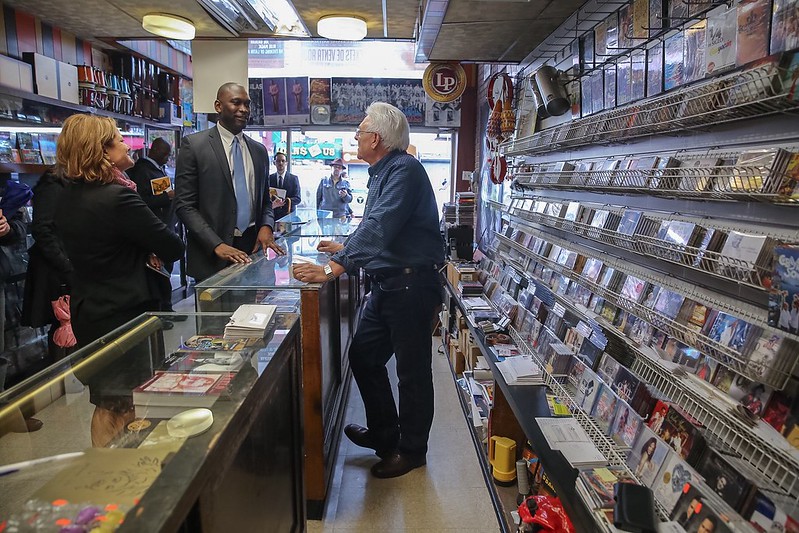
(photo: William Alatriste/City Council)
The holiday season is upon us and we all know the temptation of online shopping. The ease of getting the things we want at the click of a button might seem harmless, but it has major consequences for local small businesses.
Shopping online takes away from the livelihood of local residents and strips the community of its extraordinary businesses. E-commerce also means you don’t have the ability to inspect your purchases before receipt, you have to go through the hassle of repackaging and returning items you don’t want to keep, and you’re depriving yourself of getting to know the business owners in your neighborhood.
The better way is the smaller way. Shopping small means you’re supporting your community. Small businesses are the backbone of New York’s local economy, with over 230,000 businesses, employing 3.69 million people. Besides contributing to the workforce, small businesses connect communities and help create unique, energetic neighborhoods throughout our city.
As the holiday shopping season approaches, I’m encouraging all New Yorkers to show some love to our small businesses. Here are some ways you can help your local small businesses that extend beyond just your purchasing power:
Participate in Small Business Saturday. Avoid the Black Friday mayhem and shop small on Saturday, November 30.
Pledge Your Shopping List to Your Community. This holiday season make a commitment to buy half of your shopping list from local small businesses. Jewelry, clothing, pottery, and books are all great gifts that can be found in your neighborhood. Consider gifting a “made in New York” basket with your favorite local items.
Share Small Business Content on Social Media. A great way to support your favorite local businesses is to share their content on social media. It can be as simple as posting a picture on Instagram or checking in on Facebook.
Leave Positive Reviews. While word-of-mouth recommendations are always good for small businesses, it doesn’t hurt to leave positive reviews on Yelp and Google. Leave an online review for small businesses to get more traction and visibility.
Join the fun! Participate in seasonal fun on your block and in your neighborhood, or even in another neighborhood you enjoy or are eager to explore for the first time. From tree-lighting events to local gift guides, get involved and shop small.
While you’re preparing for this busy season, remember to continue supporting the diverse, independent small businesses that enrich neighborhoods across New York City. As we enter this busy holiday season, don’t forget to shop small!
***
Gregg Bishop is the Commissioner for the New York City Department of Small Business Services. On Twitter at @NYC_SBS and @GreggBishopNYC.
***
Have an op-ed idea or submission for Gotham Gazette? Email This email address is being protected from spambots. You need JavaScript enabled to view it.
The Right to a Free and Quality Public Higher Education in New York
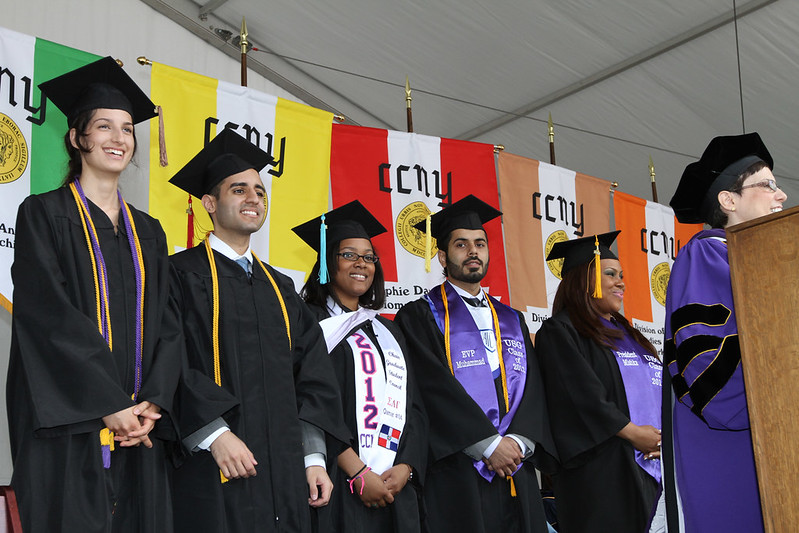
(photo: The City College of New York)
CUNY has long been the pride of New York City and its cradle of opportunity. But at a recent legislative hearing on higher education in Brooklyn, we heard from teachers, administrators, and students about a harsh reality: After years of state underinvestment in public college, our CUNY system is teetering on the edge of crisis.
Both of us have been blessed with a CUNY education. Yet both of us see firsthand the heartbreak and struggle that many students face when they seek to advance themselves through higher education. In the end, some graduate. Some don’t. And some never get to try because it’s just not affordable.
Students desperately need relief. CUNY’s six-year degree completion rate is only 55%, and financial strain is one of the main reasons students drop out. In a 2017 report on college success, the Center for an Urban Future shared that 75% of dropouts at Kingsborough Community College had a financial “red flag” in their accounts such as owing money or loss of scholarship. To make matters worse, a staggering half of all CUNY students experience food insecurity, and many struggle with housing insecurity or even homelessness.
There’s a reason for this dire situation: Tuitions have risen steadily year after year, as the share of the budget that comes from tuition has grown from 20% to almost 50% over the past 30 years.
In other words, students are bearing the burden of our failure to invest in quality public higher education.
This penny-pinching on the part of New York has led to further consequences. Adjuncts, upon whom CUNY increasingly relies, are grossly underpaid, even with a new contract that would increase the minimum pay per course. The ratio of full-time faculty to students is significantly higher than national standards. Facilities have deteriorated and class sizes have become overcrowded. These trends cause lower retention rates and greater time to graduation.
This is a downward spiral that we must stop.
In today’s age, a higher education is no less necessary to succeed in most fields as a high school diploma was two generations ago. And a college degree is a pathway to economic opportunity and financial security: according to the Bureau of Labor Statistics, a person with only a high school diploma has nearly double the unemployment rate of a college graduate and earns on average 39 percent less per week.
A CUNY education has been shown to be one of the most successful ways to bring a student from the bottom quintile in family income to the top—with a mobility rate of more than three times those of the most elite institutions.
The struggle of our CUNY students and underinvestment in our CUNY system mirrors the budget cuts for public schools across the nation that occurred after the Great Recession. State funding for public schools across the country is $9 billion below 2008 levels, adjusted for inflation, according to the Center on Budget and Policy Priorities.
Recognizing the necessity of free college, Governor Cuomo and the Legislature implemented the Excelsior Scholarship in 2017, aiming to make four-year college tuition-free for many.
Yet as of 2018, only about 3% of the state’s undergraduates benefited from the scholarship. The majority of applicants who applied were rejected because they didn’t meet the onerous credit requirements.
New York is missing out on future climate scientists, doctors, and other leaders because students can’t pay for rent, food, and a MetroCard without a job, which makes them unable to access or retain the Excelsior Scholarship.
It’s time to transform New York State with a robust promise for free higher education. We did it once before with K-12 schooling and we should boldly aim to do it again by making New York the first state in the country to constitutionally guarantee a free, quality public college education.
Higher education should not be a luxury for the few but a tool for many. Let New York lead the way and make our state a model of what a commitment to public education in the 21st century should be.
***
State Senator Andrew Gounardes represents parts of Brooklyn and is an adjunct professor at Hunter College. Timothy Hunter is chair of the University Student Senate and a CUNY Student Trustee. On Twitter @agounardes & @thunter_tim.
***
Have an op-ed idea or submission for Gotham Gazette? Email This email address is being protected from spambots. You need JavaScript enabled to view it.
The Schools Chancellor Goes Rogue on Specialized High School Admissions
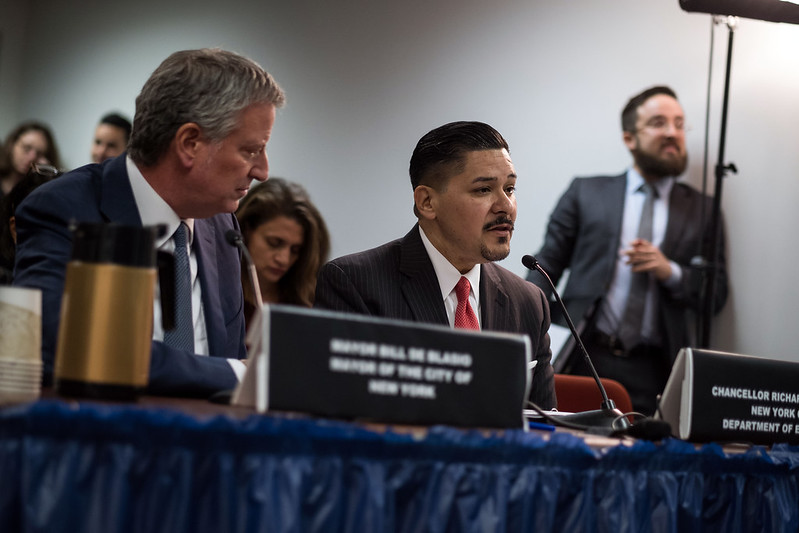
Chancellor Carranza, with Mayor de Blasio (photo: Ed Reed/Mayor's Office)
City Schools Chancellor Richard Carranza has gone rogue over the issue of what to do about the specialized high schools like Brooklyn Tech, Stuyvesant, Bronx Science, and five others that use the SHSAT, a competitive academic test to determine admissions.
While Mayor Bill de Blasio is now saying that he is open to keeping the test with some added admissions features and the City Council is convening a task force intended to include all stakeholders, which will take a year to examine the issues and make recommendations, Carranza recently demanded that the state Legislature simply “get out of the way” and repeal the state law mandating the existence of Tech, Stuy, and Science with the current admissions system.
This year saw the refusal of the state Legislature to consider the chancellor’s favored bill that would have replaced the test with geographic and other preferences intended to replace much of the Asian student admission with black and Latino students. It wasn’t surprising that many in the Asian community reacted to this by calling the proposal racist.
The chancellor claims that the state should repeal the state law, Hecht-Calandra, because it should get out of the business of running city schools. This ignores that the state gives the city over $11 billion a year to run our schools as well as the myriad of state regulations limiting the city’s unfettered discretion. The state is simply involved, and no amount of rhetoric can make that fact go away.
In return for eliminating the law that mandates the existence of Tech, Stuy, and Science, the chancellor tells the state Legislature to trust him for maintaining the quality of these schools; he says hold him accountable. Of course, that requires that he be around to be held accountable. In the past ten years we have had five different chancellors. Mayor de Blasio, who appointed Carranza, will be out of office at the end of 2021.
Carranza’s “just trust me” approach to eliminating the law mandating the existence of the three schools ignores that he and the mayor have the authority to reverse the city’s decision to voluntarily add five additional schools to the test-in requirement. We don’t have to trust him; he and the mayor can show the Legislature and the public that they can make their desired reforms with those five schools, but they choose not to.
The chancellor claims eliminating the law that mandates the existence of the best high schools in the city is necessary so he can diversify their student bodies “overnight” while maintaining their quality. But the DOE’s failure to diversify academically challenging high schools where there is no state mandated admission system belies this claim.
Of the 22 best STEM (Science, Technology, Engineering and Math) high schools in the city making Newsweek’s list of the 500 best in the country, the sad truth is that the city’s public schools were in the minority. Most of the city schools on the list are private and charge tuition, which can be over $40,000 a year. And of the public schools, the overwhelming majority were specialized high schools. Only three others, Eleanor Roosevelt, Townsend Harris and NEST (Manhattan) made the cut.
Where the city has had the unfettered right to determine admissions processes for these high-achieving STEM high schools, it has ignored the need to diversity their student bodies. At Eleanor Roosevelt, for example, which has a city-mandated preference for students coming from the Upper East Side, the school is over 60 percent white and only 4 percent black.
The city’s schools are described as being the most segregated in the nation. And the explanation for this, particularly from the mayor, is often that we have segregated housing patterns. But at Eleanor Roosevelt, the DOE is affirmatively supporting racial segregation while falsely claiming it is open to all students in the city.
Putting these facts together suggests that the state would be advised to keep the law as it is while allowing the City Council’s task force to do its job. In a very difficult environment, made more difficult by the chancellor, it may be able to heal the wounds caused by the previous effort to eliminate the test and rationally deal with the issues of promoting academic quality and diversity. Both are needed if the children of our city are to be given the best chance to excel in life.
***
Larry Cary is the President of the Brooklyn Tech Alumni Foundation. He is a practicing attorney in Manhattan.
***
Have an op-ed idea or submission for Gotham Gazette? Email This email address is being protected from spambots. You need JavaScript enabled to view it.
What New York Can - and Must - Do Right Now to Help End the Addiction Crisis
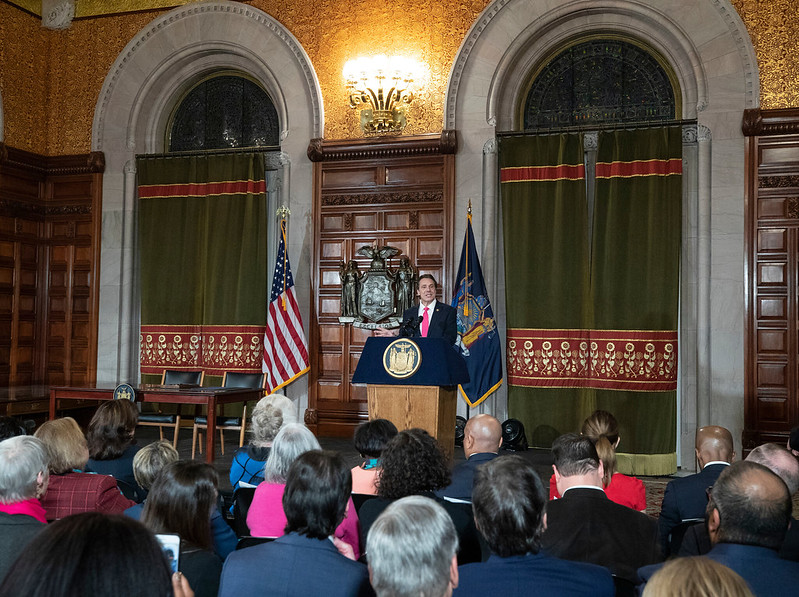
(photo: Mike Groll/Governor's Office)
When your medical career is bookended by two of the worst public health emergencies in modern American history – the heroin epidemic of the 1970s and our country’s current crisis of overdose and addiction – it gives you a unique perspective on the problem and the solutions.
To overcome this deadly crisis we must begin by viewing addiction for what it is – a treatable disease – and then bring to scale evidence-based medical strategies that we know give patients the best chance for a positive outcome.
Medication Assisted Treatment – or MAT – is the quickest, easiest-to-start weapon we have to prevent patients from exposure to possible overdose. In combination with counseling as needed, it is the most effective tool we have to combat the opioid epidemic.
MAT involves prescribing medication approved by the Federal Drug Administration to treat opioid dependence. The medications reduce cravings and withdrawal and support patients who are recovering from illicit opioid use. Patients respond differently to the dose, formulation, and delivery method given their histories and prior experiences, as agreed upon with their physician. In my experience, MAT coupled with regular counseling and medical supervision is the best chance patients have for success.
New York is poised to become the latest to join a growing list of states – politically blue, red, and purple – that are removing obstacles to MAT and instead rightly focusing on patient care and access. On-demand access to all FDA-approved medications for opioid dependence is the national trend because it is smart public health policy. California, Ohio, Texas, and Missouri are just some of the states to embrace the wisdom of MAT and pass laws or regulations to increase access and availability.
New York’s bi-partisan legislation removes burdensome and potentially deadly barriers to treatment like prior authorizations and covers the medicine under both private insurance and Medicaid. Enacting these reforms now requires Governor Andrew Cuomo’s signature.
At Damian Family Care Centers, in our various clinics in New York City and hard-hit Upstate New York, we regularly witness the difficulties involved when a patient has to wait for MAT because the insurance company or Medicaid requires prior authorization. Patients who are struggling with opioid dependence often have challenges with impulse control as part of their addiction. It is essential that the medications prescribed for the patient are available to the patient as soon as possible. Otherwise the patient will not tolerate the wait and will turn to the streets. And the streets are more dangerous than ever because of the proliferation of fentanyl, which is exponentially more powerful than prescription opioids or heroin. When fentanyl becomes part of the equation, a “regular” dose can easily become a lethal dose.
Any delay, let alone 24 to 48 hours or more, can make the difference between life and death for a patient who agrees to Medication Assisted Treatment.
The bottom line is we are in the midst of a raging opioid epidemic. If people were dying from an infectious illness, would we think it was ethical to require prior authorization for any of the possible medications? Would it be effective to limit the medicines we know can help? The doctors, nurse practitioners, and physician’s assistants on the front lines of the crisis must be able to make medical judgments in the best interests of their patients. That requires the ability to prescribe all the medications the FDA has approved for the treatment of opioid dependence.
Nearly 4,000 people died in New York State from drug overdoses in the last year, including one every six hours in New York City.
The barriers to treatment – while well-intended – were built during a different time under vastly different circumstances. The most meaningful action New York State, and all states, can take right now regarding the opioid, heroin, and fentanyl crisis is to ensure MAT is readily available to the thousands of people who need it.
***
Sonia Lopez, MD, is the Director of Addiction Medicine at Damian Family Care Centers.
***
Have an op-ed idea or submission for Gotham Gazette? Email This email address is being protected from spambots. You need JavaScript enabled to view it.
National Grid Saga Highlights Need for Public Power
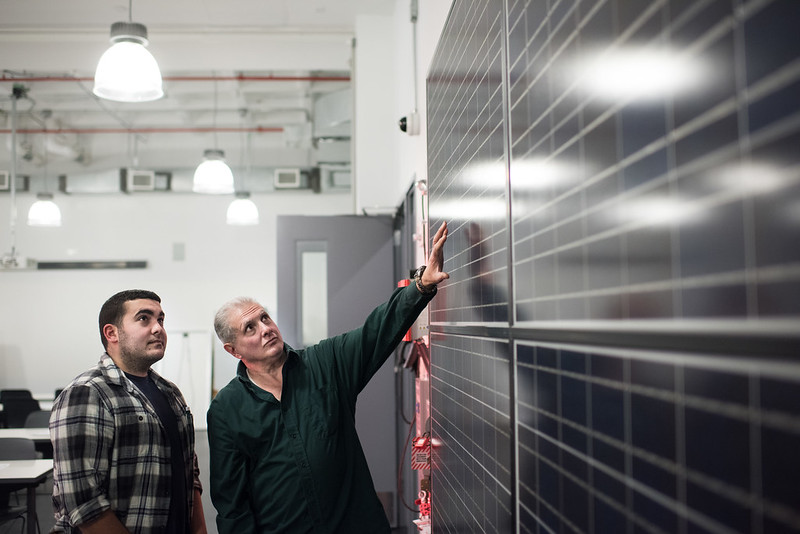
(photo: Michael Appleton/Mayor's Office)
For six months, National Grid has held New Yorkers’ gas hostage in an attempt to force through an environmentally-disastrous pipeline that those same New Yorkers fiercely oppose. Last week, Governor Cuomo finally pushed back against National Grid, in a letter threatening to revoke the company’s license to operate downstate. Considering that National Grid has stranded 1,100 households without gas in the freezing winter under false pretenses, it’s a necessary first step.
But if the next step is to give that license to another private corporation, Cuomo will only be handing the keys from one con artist to another.
Currently, our utility system—the means through which our energy is delivered from generators to users—is controlled by Investor Owned Utilities (IOUs). These are private corporations whose primary goal is to make as much money for their shareholders and executives as possible, at their customers’ expense and instead of funding necessary infrastructure improvements and the just transition to green energy.
The real story behind National Grid’s so-called “gas moratorium” illustrates its priorities perfectly. In May, the company claimed that it had to stop hooking up new gas connections, leaving businesses unable to operate and residents unable to heat their homes, because of a gas shortage that could only be remedied, they say, by the construction of the Williams Pipeline.
It’s a compelling story, save for one small inaccuracy: there is no gas shortage. Report after report show that gas demand is flat, and would actually decrease were National Grid to follow sufficient energy efficiency measures. The company’s own regulatory filings show that even after adding 12,000 more customers than predicted in 2017, gas use was 35% lower than expected. They’ve even been selling surplus gas to third parties for the last five years—hardly the actions of a company about to run out.
They are, however, the actions of a company trying to make money. And the Williams Pipeline would make National Grid a lot of money.
While the so-called “gas moratorium” is a particularly egregious example of how private utilities prioritize profits over people, National Grid is just doing what all Investor Owned Utilities are designed to do: generate profits. It’s not an exception, it’s the rule. A glance at New York City’s other major IOU, Con Edison, confirms this.
When massive blackouts shook the city earlier this year, ConEd came under fire for its failure to repair ailing infrastructure until it had literally burst into flames. One of ConEd’s many justifications for a 2013 rate hike was a $350 million program to modernize old relay systems, including the West 65 Street substation whose failure left over 72,000 people without power on July 13. ConEd got the rate hike and we got higher bills, but despite making around a billion dollars a year in profits, they never funded the relay repair project, and never made the repairs.
ConEd won’t reveal where that $350 million went, and is actually requesting another rate hike this year. We have some idea where that money went, as they are still able to pay $9.5 million a year to CEO John McCavoy, six figure retainers to each of its board members, and $846 million in shareholder dividends.
Stronger regulations can’t change the fundamental incompatibility between private profit and public need. The only solution is to wrest power from multimillionaire shareholders and put it in the hands of the public. This is the goal of Public Power NYC, and a central plank of the Movement for a Green New Deal coalition: to replace these IOUs with a Public Utility that prioritizes people over profits.
As Western Queens City Council Member Costa Constantinides wrote last week, more than 2,000 communities in the United States, including the entire state of Nebraska, get their power from publicly-controlled utilities, providing power to one in seven Americans. These public utilities have already been proven to be cheaper and more reliable than privately-owned utilities and have been leading the charge in the transition to renewable energy our planet needs to survive.
Constantinides is one of a rising number of elected officials who support bringing utilities under public ownership and, as chair of the Council’s environmental protection committee, his voice carries some additional weight in New York City. However, the change we need can only come when our representatives in Albany wake up to the failure of the status quo.
State Senator Kevin Parker and Assembly Member Michael Cusick, as the chairs of their respective state committees on energy policy, have the opportunity to fix the fundamental flaws of our investor-owned system, and we call on them to lead on bringing our utilities under public control.
To be sure, no public utility is perfect, and existing public utilities must go further to combat climate change. But the difference between private and public utilities is that they can go further, because they can be truly democratic and accountable to the people they serve.
We only have to look at the incredible aid work in the face of disaster by groups like Occupy Sandy to see what democratic control could look like. When the storm hit, it was ordinary people who came together, ultimately setting up an extensive relief network that provided thousands of meals and delivered vital supplies. They didn’t run the numbers to make sure it was profitable, demand payment in return, or blame storm victims for their circumstances. They just came together, pooled their resources and skills, and helped each other survive.
Imagine if this community solidarity could be harnessed before disaster strikes, and used to shape systems with the same values that made those relief efforts possible. A truly democratic and accountable public utility will make decisions in, and only in, the public interest. It will prioritize safety, reliability, and affordability. It will decarbonize as quickly and comprehensively as the planet requires. And it will do this all with union workers making good wages and full benefits, with provisions to hire from—and invest in—the marginalized communities who have been hurt most by the last century of private, polluting energy regimes.
This is what Public Power makes possible, and why it will be a vital part of any Green New Deal—be it for New York, the United States, or the world. The engines of private profit have been driving our energy system for decades, and they’ve nearly run our planet off a cliff. They need to be replaced with the engines of public good, powered not by thirst for private profit but by the desire to meet our communities’ needs in the best and most sustainable ways possible.
***
Charlie Heller is a member of the New York City Democratic Socialists of America, Ecosocialist Working Group; Jamie Tyberg is a member of New York Communities for Change; and Alex Beauchamp is a member of Food & Water Action. On Twitter @NYCDSA_Climate, @jtbrg, and @AlexAtFWW.
***
Have an op-ed idea or submission for Gotham Gazette? Email This email address is being protected from spambots. You need JavaScript enabled to view it.
New York Needs to Make Young Voters a Priority - Here’s How
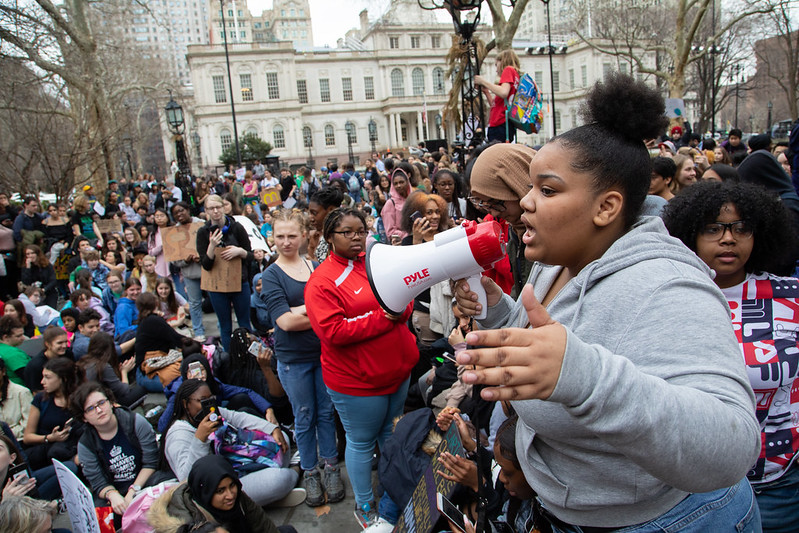
(photo: Paige Polk/Mayoral Photography Office)
2018 was an historic year for youth voter turnout across the country. Just not in New York. Nationwide, 31% of young voters (ages 18-29) made it to the polls. In New York, that number was about 16.4%, the second-worst in the nation in states for which we have data. New York’s young voters are not more apathetic than other states; instead, we have an election system that does not facilitate our participation, and in fact suppresses it.
Our organization, Generation Vote, works to empower young people across the state to participate in the political process and make their voices heard. We hear stories from young people on the ground who tell us that opportunities to register to vote are limited, registration deadlines are restrictive, and closed party primaries restrict new voters from participating in such elections. They also cite policy decisions made at the local level, such as poll sites placed in locations away from both college campuses and public transit, which place further obstacles to youth participation.
Young people are forced to enter the electoral process at a time when their lives are highly transient and unstable, when the process to vote is often most complicated, and before they have had a chance to develop a habit of participation. Next year, voters between the ages of 18-29 will make up 40% of the voting-age population. Our generation, which is the most diverse in our country’s history, will live with the decisions made today and tomorrow for the rest of this century and needs to have a say in that future.
New York has the potential to empower young voters for next year’s crucial elections and beyond.
We need to make youth voting rights and engagement a renewed priority for reform in New York State. This will require a two-pronged approach: one is removing statutory barriers to youth voting in New York, and the other is creating avenues for authentically engaging youth voices in the political process.
There is an array of possible reforms suggested by youth voting experts at the Center for Information and Research on Civic Learning and Engagement (CIRCLE) at Tufts University and the Fair Elections Center. These include automatic voter registration, lowering the voting age to 16, codifying the re-enfranchisement of people on parole, and mandating on-campus poll sites.
These reforms will remove barriers to accessing the polls for young people, opening up the process to new voters. They should form the basis of a new pro-youth voting reform package taken up by Governor Cuomo and State Legislature at the start of the next legislative session in January.
Thankfully some key pieces are already in motion in New York, such as pre-registration for 16- and 17-year-olds; same-day registration, which is likely to appear on the ballot for New York voters in 2021; and a bill that would require SUNY and CUNY college campuses to expand their voter registration practices, which awaits the governor’s signature to become law.
We also have to build a culture of participation and engagement that authentically brings young voices into the process. Steps including the creation of a youth delegation to state government, embedding standardized civic education into our schools, and lowering the age requirement to be a poll worker to 16. Building a culture of engagement will make voting a part of a wider civic experience, and create a healthier democracy.
With 2020 around the corner, the stakes have never been higher for New York to make it simpler, not harder, for young voters to make their voices heard. At Generation Vote, we’ve already hit the ground running with the first New York Youth Voting Rights and Engagement Summit, which took place on November 9.
We’re bringing together young people from across the state to build on our work as part of the Let NY Vote Coalition by creating a new agenda for youth voting rights in New York State. If you want to help us build a democracy which authentically includes young people, visit our website and find us on social media, then get in touch and involved.
***
Garrett Shor, COO, and Brianna Cea, CEO, are co-founders of Generation Vote. On Twitter @GenVoteUS.
***
Have an op-ed idea or submission for Gotham Gazette? Email This email address is being protected from spambots. You need JavaScript enabled to view it.